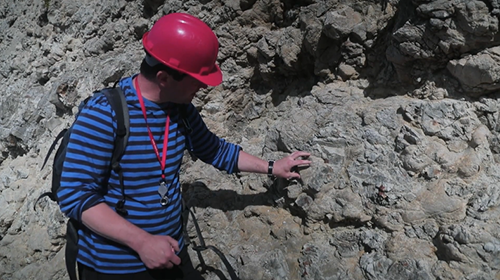- Group size: 36 students
- Teaching type: Remote live sessions and resources in Canvas
- Division: MPLS
- Subject: Earth Sciences - Geology
- Tools: Canvas, Zoom, Gather.town
Delivery
Every year in late September, Oxford undergraduates just entering second year go on a field trip to the Dorset “Jurassic” coast – a world heritage site. Part of the purpose is to provide bridging material by revisiting some of the skills acquired in first year, and to introduce the type of thinking that will be required in second year. Due to the pandemic, this trip was not possible in 2020. The Oxford team recruited professional film makers who shot footage of faculty members doing geological field work in the area, as well as drone footage, both of which covered most of the major places and topics that would be covered during an in-person course. The pre-recorded videos were uploaded to Panopto and made available in a Canvas course area, together with the daily schedule and other resources.
The Oxford team designed accompanying exercises and adapted the usual field guide for students to make notes (including drawing sketches) and complete the exercises. The design aimed to achieve good balance of paper-based, hand-written work, online activities, and the video footage.
Live sessions were held to help students keep on track; and remote practical sessions were held on Gather. Students could (virtually) ‘wander up’ to demonstrators and experts (as they might in a face-to-face session) and ask questions. When circumstances allowed, face-to-face sessions were held in the department, for students to examine and discuss rock and fossil specimens from the field.
Strengths
- Student feedback was very positive – they particularly loved the professionally-made field recordings, including the drone footage.
- Daily schedules were carefully planned in a flexible way, with clear deadlines and provision for comfort and refreshment breaks.
- The film makers used a two camera set-up to capture both head shots and wide angle simultaneously – very useful for the large scale of vistas we wanted to include.
- The film makers provided a ‘draft’ audio stream first for approval (based on notes and prior conversations) to ensure that the script was correct, before finalising the most appropriate video and drone footage, as well as adding in photos, images, graphics and animations where relevant. This enabled dynamic and effective collaboration between the film maker and the academic team.
- The project has yielded long-term benefits in the form of video resources that can be used in future as background or preparatory material for students (including during live field trips in the future), or for the purposes of open days and outreach initiatives. The development of additional exercises has also been useful for future field trips and how we integrate the field class into taught courses and tutorials.
Limitations
- A significant amount of time was required to plan it and put it all together.
- One can’t cover anywhere near as much content or detail in a virtual environment as you would normally do on a physical field trip.
- Seeing rocks on films is no substitute for seeing them with your own eyes across a large range of scales!

Video still from the Dorset field trip, with the professor explaining some points of interest.
- Contributed by: Professor Stuart Robinson, Dept of Earth Sciences and St Anne’s College.